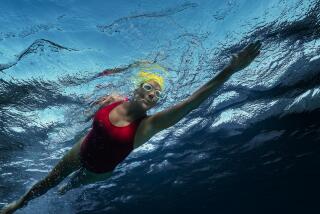Review: ‘Swimming Studies’ and a life shaped by the pool
Swimming Studies
A Memoir
Leanne Shapton
Blue Rider Press: 336 pp., $30
Leanne Shapton did not go to the Olympics, she tells us on the first page of “Swimming Studies” — but she did get to the Olympic trials. She was, according to her finish there, the eighth-fastest breaststroker in Canada in 1988, but only the top two went to the Olympics.
Although she’s modest about it, that’s a phenomenal achievement. In this essayistic, illustrated, meditative memoir, Shapton explores swimming from many dimensions: its pools and its suits, what it meant to her then and what it means now. She’s in her late 30s, and swimming remains for her a thing of longing and belonging.
“When I was twelve a coach remarked I had a ‘feel’ for the water,” she writes. “I still do. It’s a knowledge of water space, being able to sense exactly where my body is and what it’s affecting, an animal empathy for contact with an element.… When I’m dry I bump into things, stub toes, miss stairs.”
Shapton has spent plenty of time on land, where her accomplishments have also piled up. She’s been an art director at the New York Times and is an accomplished illustrator who has designed book covers and textile prints. She wrote 2009 novel “Important Artifacts and Personal Property From the Collection of Lenore Doolan and Harold Morris, Including Books, Street Fashion and Jewelry,” which was written in the form of a high-end auction catalog and, despite that unusual format, was optioned by Brad Pitt. It looks like Shapton can succeed at whatever she puts her mind to; swimming is where that started.
As kids, she and her elder brother began taking swim lessons in Ontario, Canada; he dropped out and she kept going. She writes of team dynamics, frigid early mornings, mechanics of turns, the intensity of practice. “After workouts and races, I would sit in the bleachers with a styrofoam cup of frozen water, rolling the flat ice against the insides of my knees until they lost all feeling,” she writes, bringing the daily routine of a nationally ranked athlete to life with a simple detail.
Appearing unannounced in the text are several pieces of Shapton’s art: There are watercolor-like paintings of swimmers in action, abstract portraits of members of her team, and a series of swimming pools floating in white space. There is fun in her art: a two-page spread of colored blobs designed as a swimming-scent scratch-and-sniff, with descriptions of fantastical odors: “13. Fingernail: Chlorine, barbecue potato chip, wool mitten.”
As few people can, Shapton draws a connection between making art and being an athlete, focusing on the unending effort it takes to do well. “Artistic discipline and athletic discipline are kissing cousins, they require the same thing, an unspecial practice: tedious and pitch-black invisible, private as guts, but always sacred,” she writes. In her world, it’s not inspiration but painting the same hillside over and over, as she does in Switzerland, that is the way to (possible) greatness.
Her narrative switches between her youthful experience as a swimmer and the rough present. As an adult, she restlessly cooks before dawn; when she travels, she seeks pools of all kinds. She quits swimming, then finds herself skipping European discos to go watch strangers’ swim practices, and returns to competition again. Not that this makes her content. Leaving one workout she thinks, “You can’t choose what you’re good at, but does that mean you should do it?”
The book dwells in that place of restless contemplation. Where another memoirist might evoke friends in detail or let conversations play out on the page, Shapton often chooses to go with internal narration. That’s not the only way she skirts traditional memoir: “I can’t find a swimsuit in Toronto the day before my wedding reception,” she writes, following it up with a description — not of the wedding, but of the hotel’s swimming pool.
The book’s center section can be seen even when it’s closed as a blue stripe in the middle pages. It has a trifold narrative: First are photos of her bathing suits, racing and vintage, printed full-bleed and with a blue overlay, creating that visible blue band. An essay, mostly about eating, runs along the tops of the facing pages. And on the bottom of the pages, in smaller font, are descriptions of the suits as artifacts: what brand and where they were purchased and worn, in places like the Chateau Marmont, Morocco, Sweden and Les Bains du Marais in Paris. It’s a three-way story about bodies and fashion and effort and luxury in which the pictures are essential.
Shapton’s experiments do not always pay off — there may be more repetitive painting series than are necessary to make her point about practice — but they are always interesting. She is, no doubt, a creative powerhouse, one who puts words and pictures together with a quiet force that comes only from solid, dedicated practice.
More to Read
The biggest entertainment stories
Get our big stories about Hollywood, film, television, music, arts, culture and more right in your inbox as soon as they publish.
You may occasionally receive promotional content from the Los Angeles Times.







